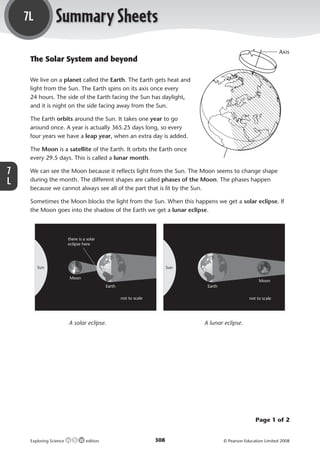
The Solar System and Beyond
- 1. 7L Summary Sheets Axis The Solar System and beyond We live on a planet called the Earth. The Earth gets heat and light from the Sun. The Earth spins on its axis once every 24 hours. The side of the Earth facing the Sun has daylight, and it is night on the side facing away from the Sun. The Earth orbits around the Sun. It takes one year to go around once. A year is actually 365.25 days long, so every four years we have a leap year, when an extra day is added. The Moon is a satellite of the Earth. It orbits the Earth once every 29.5 days. This is called a lunar month. 7 We can see the Moon because it reflects light from the Sun. The Moon seems to change shape L during the month. The different shapes are called phases of the Moon. The phases happen because we cannot always see all of the part that is lit by the Sun. Sometimes the Moon blocks the light from the Sun. When this happens we get a solar eclipse. If the Moon goes into the shadow of the Earth we get a lunar eclipse. there is a solar eclipse here Sun Sun Moon Moon Earth Earth not to scale not to scale A solar eclipse. A lunar eclipse. Page 1 of 2 Exploring Science edition 308 © Pearson Education Limited 2008 M12_ES_AB_Y7_2445_U7L.indd 308 4/3/08 12:30:01
- 2. 7L Summary Sheets (continued) The Earth’s axis is tilted. When the northern hemisphere is tilted towards the Sun it is summer in the UK. Days are longer than nights, and the Sun is higher in the sky. The Sun’s rays are more concentrated, so it feels hotter. N N UK Sun’s rays Sun’s rays UK The Sun’s rays The Sun’s rays are concentrated are spread out S in the summer in the winter S There are eight planets orbiting the Sun and three dwarf planets. There are also lots of asteroids, 7 which are small lumps of rock, and comets. Most of the planets have moons orbiting around L them. The Sun, the planets and their moons, and the asteroids and comets make up the Solar System. The eight planets are Mercury, Venus, Earth, Mars, Jupiter, Saturn, Uranus and Neptune. Asteroid belt Uranus Sun Pluto Saturn Ceres Eris Mars Venus Earth Neptune Mercury Jupiter Planets do not make their own light. We can sometimes see the planets because they reflect light from the Sun. The Sun is a star. It is a ball of gas that gives out large amounts of heat and light. The Sun is like the stars you can see in the sky at night. The stars do not look very bright because they are a lot further away than the Sun. People often group stars into patterns called constellations. The Sun is one of millions of stars in our galaxy, which is called the Milky Way. There are millions of galaxies in the Universe. The stars are a very long way from Earth. Scientists measure distances to the stars using light years. A light year is the distance that light can travel in one year. Page 2 of 2 Exploring Science edition 309 © Pearson Education Limited 2008 M12_ES_AB_Y7_2445_U7L.indd 309 4/3/08 12:30:02